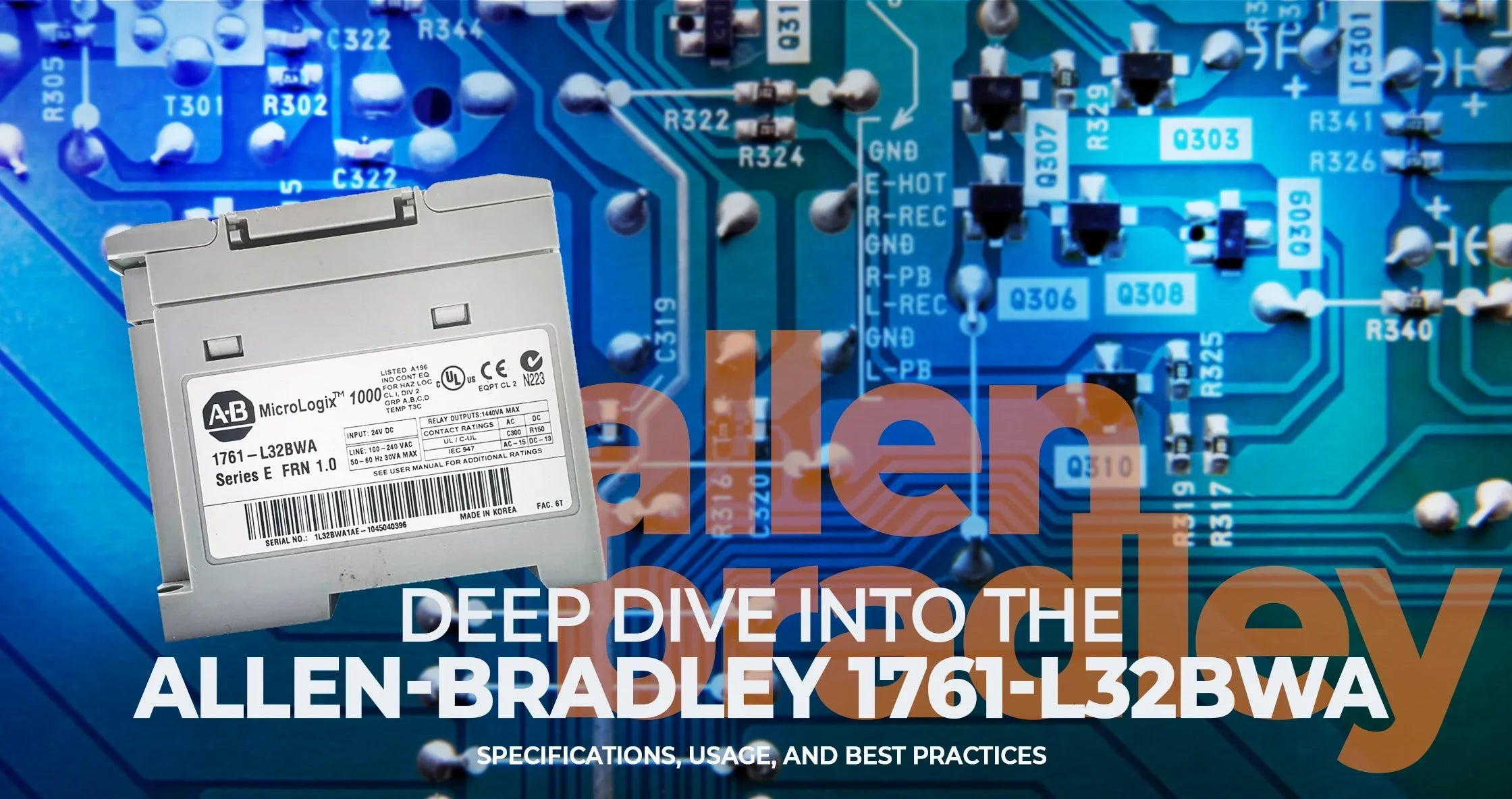The Allen-Bradley Micrologix 1000 1761-L32BWA is a discontinued yet highly recognized programmable logic controller (PLC) module from Rockwell Automation. Even though newer PLC models have taken its place in modern automation systems, the Allen-Bradley Micrologix 1000 1761-L32BWA still plays an important role in legacy setups and small-scale applications across industries. Known for its compact design, reliability, and straightforward operation, this unit is particularly valued in industries that prioritize stability and cost-effectiveness over advanced features.
This article provides a complete exploration of the Allen-Bradley Micrologix 1000 1761-L32BWA, including its detailed specifications, the importance of each feature, wiring considerations, real-world applications, revision history, comparison with modern PLCs, and best practices for long-term use.
Introduction to the Allen-Bradley Micrologix 1000 1761-L32BWA
The Allen-Bradley Micrologix 1000 1761-L32BWA is part of the MicroLogix 1000 Programmable Controllers family, which was introduced as an economical PLC solution for small automation tasks. With 20 digital inputs and 12 relay outputs, it provides 32 total I/O points in a compact chassis, powered by a wide-range AC power input of 85–264 VAC at 47–63 Hz. Its design prioritizes simplicity, offering reliable on/off control without advanced analog capabilities.
While newer MicroLogix models such as the 1100 and 1400 series add Ethernet connectivity, analog options, and expanded memory, the Allen-Bradley Micrologix 1000 1761-L32BWA remains a trusted option in legacy systems due to its nonvolatile EEPROM memory, rugged environmental tolerance, and durable relay outputs.
Technical Specifications of the Allen-Bradley Micrologix 1000 1761-L32BWA
Input/Output Configuration
● 20 Digital Inputs: 24V DC (sourcing or sinking configurable).
● 12 Relay Outputs: Dry contact, capable of switching AC or DC loads.
Why it matters: With 32 total I/O points, this controller is well-suited for small automation systems. The ability to configure inputs as sinking or sourcing gives flexibility in wiring sensors and switches, while relay outputs / switching inductive loads offer isolation and versatility across load types.
Power Supply
● Input Voltage: 85–264 VAC, 47–63 Hz.
● Consumption: ~16 VA at 120V, ~22 VA at 240V.
● Inrush Current: 30A for 4 ms.
Why it matters: The wide voltage range makes it usable worldwide without additional conversion. The short inrush current detail is critical for selecting upstream fuses or circuit breakers to avoid nuisance tripping.
Memory and Processing
● Program Memory: 1 KB EEPROM.
● Instruction Capacity: ~737 instructions.
● Data Words: ~437 data words.
● Scan Time: ~1.5 ms per 500 instructions.
Why it matters: The nonvolatile memory ensures programs remain stored even during power loss. This makes the controller resilient in industrial environments prone to outages. The scan speed, though modest compared to modern PLCs, is adequate for discrete control tasks.
Environmental Ratings
● Operating Temperature: 0–55 °C.
● Shock Resistance: 9.0 g (panel mount), 7.0 g (DIN rail).
● Humidity: 5–95% non-condensing.
● Vibration: 5–55 Hz at 0.381 mm displacement.
Why it matters: These specifications demonstrate the ruggedness of the Allen-Bradley Micrologix 1000 1761-L32BWA in challenging industrial environments. It can be mounted in standard control panels without concern for typical vibration or shock.
Physical Characteristics
● Dimensions: Approx. 200mm × 73mm × 80mm.
● Mounting: DIN rail or panel mount.
● Wiring Terminals: 22–14 AWG, 2 wires per terminal supported.
Why it matters: The compact size saves panel space, while flexible mounting and wiring support make it easier for electricians and engineers to integrate into existing control cabinets.
Relay Output Ratings
● Contact Rating: 2A maximum at resistive loads.
● Isolation: 1500 VAC between logic and outputs.
Why it matters: Relay outputs allow direct control of small motors, solenoids, and contactors. However, inductive loads require proper suppression (diodes, varistors, or RC snubbers) to protect the relay contacts and extend service life.
Wiring and Installation Considerations
Proper installation is critical to ensure longevity and reliable operation of the Allen-Bradley Micrologix 1000 1761-L32BWA.
Input Wiring
Inputs should be connected according to the sourcing or sinking configuration required by the sensors. Shielded cables are recommended in high-noise environments.
Output Wiring
Relay outputs should never exceed rated current. For inductive loads such as solenoids or contactors, surge suppression must be installed to protect against voltage spikes.
Grounding
The chassis ground terminal must be connected to functional earth. This minimizes electromagnetic interference and protects the controller during transient surges.
Power Protection
Fuses or miniature circuit breakers rated according to the PLC’s consumption and inrush current should be installed upstream.
Applications of the Allen-Bradley Micrologix 1000 1761-L32BWA
The Allen-Bradley Micrologix 1000 1761-L32BWA has been used across various industries due to its simplicity and reliability.
1. Manufacturing Automation
Widely deployed in small machines, such as:
● Conveyor belt control
● Packaging machinery
● Simple robotic handling systems
2. Material Handling
In warehouses and distribution centers, it supports:
● Sensor-based sorting systems
● Diverters and routing mechanisms
● Palletizers and stackers
3. Process Control
Though lacking analog I/O, it can manage on/off process tasks like:
● Pump and fan control
● Valve sequencing
● Alarm and indicator logic
4. Utilities and Infrastructure
In smaller municipal or utility systems, it has been used for:
● Water treatment plant subsystems
● Lift stations
● Street lighting and traffic signal control
Revision History and Series E
The Allen-Bradley Micrologix 1000 1761-L32BWA was released in multiple series (A through E). Each series incorporated improvements:
● Series A/B: Initial models with baseline features.
● Series C/D: Improved reliability, firmware updates.
● Series E: Final revision, included enhanced surge protection and compliance with updated standards.
Understanding the revision is important when replacing units, as slight changes in terminal mapping or firmware compatibility may exist.
Comparison with Modern PLCs
While still functional, the Allen-Bradley Micrologix 1000 1761-L32BWA lacks features now standard in PLCs.
Micrologix 1100/1400
● Built-in Ethernet for programming and HMI communication.
● Analog I/O support.
● Expanded memory for larger programs.
CompactLogix / ControlLogix
● Scalable architecture with higher I/O capacity.
● Real-time motion and PID capabilities.
● Advanced communication protocols (EtherNet/IP, DeviceNet).
Why this matters: For new designs, modern PLCs offer scalability and future-proofing. However, for maintaining existing systems, the 1761-L32BWA remains sufficient.
Advantages of the Allen-Bradley Micrologix 1000 1761-L32BWA
● Compact and cost-effective design.
● Reliable EEPROM memory for program storage.
● Simple programming interface for smaller tasks.
● Wide AC power input range for global usability.
● Durable relay outputs for varied load control.
Limitations
● Discontinued, availability limited to surplus or refurbished markets.
● No analog I/O, restricting process control applications.
● Limited memory and scan speed compared to modern PLCs.
● Relay contacts with finite life cycle.
Best Practices for Long-Term Use
● Maintain Spares: Stock refurbished or unused spare units.
● Document Programs: Keep backups of logic files in secure storage.
● Plan for Migration: Consider transitioning to Micrologix 1100/1400 or CompactLogix systems.
● Regular Maintenance: Inspect wiring, relays, and grounding for wear.
● Load Protection: Always use surge suppressors on inductive loads.
Conclusion
The Allen-Bradley Micrologix 1000 1761-L32BWA remains a highly reliable PLC for discrete control and small automation systems. Its robust specifications—including 20 inputs, 12 relay outputs, wide AC input range, and EEPROM memory—make it a dependable choice for legacy and small-scale projects. While limited in scalability and analog capabilities, it still fulfills its role effectively in many facilities.
If you are managing systems that currently use the Allen-Bradley Micrologix 1000 1761-L32BWA, it’s wise to maintain spares and consider future migration paths. To learn more about this controller and explore available options, visit the Allen-Bradley Micrologix product page →.
Related Product Collections
To further support your automation and control system needs, explore these product collections available at Industrial Electrical Warehouse:
Find legacy and hard-to-source automation parts, including older Allen-Bradley modules and PLCs, perfect for facilities maintaining legacy systems.
2. Automation & Controls: PLC’s / Input & Output →
Browse our wide selection of PLCs, I/O modules, and controllers designed for small to large automation systems.
Explore essential accessories and components such as power supplies, relays, and starters that integrate seamlessly with your PLC systems.


